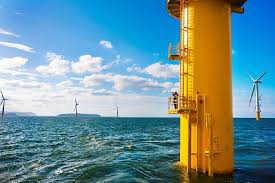Win Power
Light Weight Wind Turbine Design

Lightweight Design of Wind Turbine Structures
The design of foundation structures for offshore wind turbines is primarily governed by fatigue. To achieve a cost-effective solution, the tower diameter must be optimized: large enough to provide the required natural frequency, yet small enough to minimize material and production costs. However, lightweight tower designs are inherently more fatigue-sensitive, which can significantly reduce their expected service life.
Ultrasonic Peening for Life Extension
To address this challenge, ultrasonic peening treatment (UPT) can be applied to critical welds. This advanced surface treatment introduces beneficial compressive residual stresses, thereby increasing fatigue resistance and extending the operational life of welded joints. Ultrasonic peening can be used in two complementary ways:
- Life extension of conventional tower designs, ensuring safer and longer service periods.
- Enabling lighter structures by reducing the required wall thickness without compromising structural reliability.
Studies indicate that wall thickness reductions of up to 30% could be feasible if fatigue were the only limiting factor. In practice, however, other considerations such as buckling and drivability set lower bounds on thickness. A conservative 10% reduction is considered realistic, still resulting in substantial material savings.
For example, in an offshore wind farm with 100 turbines, each tower weighing approximately 167 tons, a 10% weight reduction corresponds to a saving of 1,670 tons of steel.
Environmental Benefits
- Lower carbon footprint: Steel production is highly energy-intensive and emits large amounts of CO₂. Reducing steel consumption directly lowers the environmental impact of wind farm construction.
- Resource efficiency: Less raw material extraction and processing reduces ecological disturbance and conserves natural resources.
- Improved sustainability: By combining lightweight design with ultrasonic peening for durability, wind turbines can deliver more renewable energy over a longer lifespan with a reduced material footprint.
Economic Savings
- Material savings: A 10% reduction in steel demand yields significant cost reductions, especially given the rising global steel prices.
- Lower welding costs: Reduced wall thickness decreases weld metal volume, welding time, and associated energy consumption.
- Reduced transport and installation costs: Lighter towers are easier and less expensive to handle, ship, and install offshore, contributing to lower overall project costs.
- Extended service life: By mitigating fatigue through ultrasonic peening, maintenance needs and replacement costs are significantly reduced, improving the lifecycle economics of the wind farm.
Relevance for Floating Offshore Wind Turbines
In the rapidly expanding floating offshore wind sector, weight savings become even more critical. Lighter structures reduce loads on floating substructures and mooring systems, improving stability and lowering costs. Simultaneously, enhanced fatigue endurance through ultrasonic peening ensures that these innovative floating systems can achieve the reliability and long service lives required for commercial viability.
Conclusion
Combining lightweight design with ultrasonic peening technology not only improves the economic feasibility of offshore wind projects but also contributes to environmental sustainability and long-term structural reliability.
